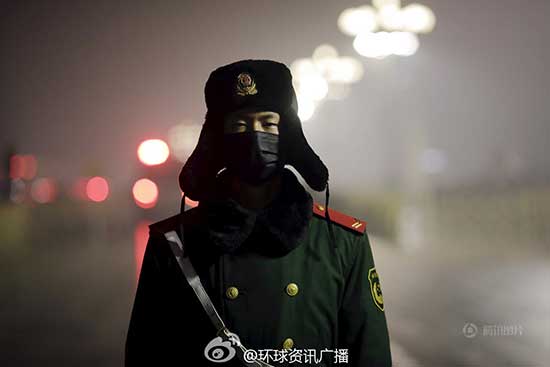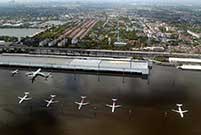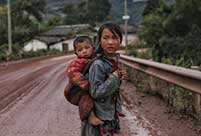

 |
| Photos taken on December 9, 2015 show paramilitary soldiers patrol in masks at Tiananmen Square in Beijing, capital of China, due to the heavy smog that has enshrouded the city recently. |
Beijing on Friday issued its second air pollution 'red alert,' the highest emergency response level, this winter, as a new round of heavy smog is forecast to blanket northern China.
The 'red alert' will last 89 hours, taking effect from 7 am on Saturday (Dec 19) until 12:00 am on Wednesday (Dec 23).
During the period, vehicles are ordered to run on roads based on odd or even license plate numbers. In addition, 30 percent of government-owned cars will be taken off from streets on an odd/even basis.
Public education institutions, including kindergartens, primary as well as middle schools, are advised to suspend classes.
Hebei province, the capital's neighbor, has already issued orange alert (the second highest) starting from 12:00 am on Friday, with one of its cities Handan on red alert and other cities like Cangzhou, Shijiazhuang, Hengshui, Tangshan and Langfang in orange.
Beijing's environmental watchdog issued its first air pollution alert last Monday, and the emergency response lasted 53 hours.
In November, the capital saw its readings of PM2.5 - hazardous particulate matter smaller than 2.5 microns in diameter - soar to 118 micrograms per cubic meter on average, a year-on-year increase of 39 percent, according to the monthly report released by the Ministry of Environmental Protection.
The city saw four more days with heavy pollution in November compared with the same period last year, it said.
Coal burning and car emissions are some of the major sources of air pollution in northern China, according to experts.
In winter, an increase in coal-burning for heating in the north and still weather often exacerbate other forms of pollution and create periods of heavy smog lasting days.
Shenyang in Northeast China's Liaoning province had the worst air pollution among the 74 major cities in the nation, and the other two northeastern provinces - Heilongjiang and Jilin - also saw their capital cities listed in the top 10.
The three provinces were blanketed by heavy haze in the first two weeks of November due to the start of central heating services, which consumes large quantities of coals.
The extreme readings of PM2.5 have surged to around 1,400 micrograms per cubic meter in Shenyang. The national safety level is 75.
In addition to the three cities in the northeast, the seven other worst polluted cities were in the northern region, especially from Hebei province.
Among the 11 cities in the Beijing-Tianjin-Hebei area, eight had more than 15 days with severe air pollution, including Beijing.
On Nov 30, heavy smog covered 70 cities, an area of more than 530,000 square kilometers, similar to the land area of France, it said.
The environmental watchdog said soaring coal consumption from heating plants was the major reason for the alarmingly severe smog.
 Are these the world’s scariest landing strips?
Are these the world’s scariest landing strips? In pics: Left behind children in China
In pics: Left behind children in China Eight modern day engineering marvels of China
Eight modern day engineering marvels of China Chinese beauty with sexiest bottom
Chinese beauty with sexiest bottom Charming female bodybuilders of Chengdu University
Charming female bodybuilders of Chengdu University Polish sports stars strip off for risqué calendar
Polish sports stars strip off for risqué calendar Spectacular aerial photos of the Three Gorges
Spectacular aerial photos of the Three Gorges Contestants of Mrs. Globe pose for photo in Shenzhen
Contestants of Mrs. Globe pose for photo in Shenzhen
 Bikini models attend hot pot banquet in Hefei
Bikini models attend hot pot banquet in Hefei Top 20 hottest women in the world in 2014
Top 20 hottest women in the world in 2014 Top 10 hardest languages to learn
Top 10 hardest languages to learn 10 Chinese female stars with most beautiful faces
10 Chinese female stars with most beautiful faces China’s Top 10 Unique Bridges, Highways and Roads
China’s Top 10 Unique Bridges, Highways and Roads Managing migrants
Managing migrants Hazy understanding
Hazy understanding Express delivery booming
Express delivery booming Cyberspace can’t be safe haven for criminals of any nation
Cyberspace can’t be safe haven for criminals of any nationDay|Week